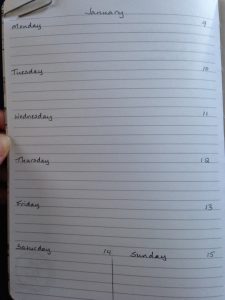This month, I am going to pay closer attention to my shopping habits. I’m allowed to buy things as usual, but I aim to keep two detailed records:
- Keep an ongoing wish list of things I want, including those little thoughts that pop up and flit away as quickly – ‘I should try that soap’, ‘when this breaks I’ll look into a replacement,’ ‘next time I buy shoes I’ll look at ___.’
- Keep a list, each day, of everything I purchase.
There are a few reasons why I’m doing this.
First of all, I suspect I do more shopping than I think I do. Now, I tend to label myself as a person who doesn’t buy that much; certainly not compared to others in my demographic. However, I feel like I manage to sneak in quite a lot of shopping for things that are useful, secondhand, and/or inexpensive – so I never feel hugely guilty and thus never pay much attention to these purchases. I also do a lot of shopping ‘in dribs and drabs’. That is, I rarely go out and buy a ton of stuff at once. I just buy a spoon one week, a piece of clothing the next week, some pieces of fabric a few days later… and so on. But when the charge comes through to the bank account, sometimes I can’t remember what it was for. So although I’m never going on a spending spree, I think I’m shopping a lot in small doses, without being fully conscious of it.
So what I want is to have a more accurate awareness of what I buy.
Second, I also suspect that I spend a lot of time researching what to buy, shopping around, just going to look at it, reading reviews. This might be a good thing; but I also feel that I sink a lot of energy into deciding what to buy in many cases when I don’t need the item in the first place – or I could use something I already have if I just thought creatively.
So I want to keep tabs on how much time I spend thinking about what to buy.
Finally, I’m feeling a need to audit what I’m bringing into the house as a complement to my zero waste project. As I’ve been trying to reduce how much waste we produce, I’ve kept close tabs on what leaves the house and tried to find less wasteful alternatives to what we regularly use. But sometimes the problem is with what enters the house in the first place (and the how and why), and the solution is to refuse it at the source. It is much easier to say ‘no’ to something altogether than to research secondhand options, sustainable options, package-free options, drive around shopping or order online, and then separate out bits of packaging to recycle and reuse.
So I want to identify what I’m acquiring and why, in order to assess whether my life might be simpler if I just refused it in the first place.
Having resolved this grand plan one evening, and planning to keep my careful records in my calendar for 2017, I realised: I don’t have a 2017 planner. Immediately I was online, thinking about what I wanted and where I might find it…BUT!
I realised this was my first challenge. You know what I did? I took one of my collection of many ruled journals and made my own planner.
I always thought of planners as somehow specialty items, as if they contained some kind of elaborate, privileged information. But the days of the year are publicly available knowledge! In fact, I took the 2017 advance-planning page from my previous planner and used it to get the correct days for this one.
This project illustrated all the reasons why I want to be more thoughtful in how I shop: instead of turning to acquisition to solve every problem, I want slow down enough to see what I already have and use it creatively.
